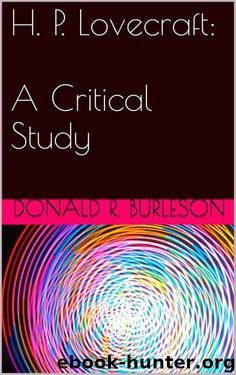H. P. Lovecraft: A Critical Study (Classics of Lovecraft Criticism Book 1) by Donald R. Burleson

Author:Donald R. Burleson [Burleson, Donald R.]
Language: eng
Format: epub
Tags: Literature & Fiction, History & Criticism, Genres & Styles, Horror & Supernatural, Criticism & Theory
Amazon: B01ATX9X9Q
Publisher: Hippocampus Press
Published: 2016-01-17T23:00:00+00:00
112 the spot “into which all the ghouls of the waking world cast the refuse of their feastings.” Carter forms an alliance with the ghouls of the dream realm, one of which is a hideously transmuted Richard Upton Pickman, the artist who vanishes at the end of Lovecraft’s tale “Pickman’s Model.”
The novel, too, is replete with symbolism that reinforces the propriety of a Jungian interpretation, as when Carter, entering the Enchanted Wood of the creatures called Zoogs, finds “a circle of great mossy stones” left by “older and more terrible dwellers long forgotten.” The circle readily suggests the mandala (an archetypal symbol, in fact, often occurring in dreams and in children’s art), the Jungian circle of individuation, the nature of Carter’s approaching quest for psychic oneness; Carter must confront the Shadow, the gods of Kadath, and must by reconciling this Dark Brother with his outward-turned ego, complete the circle to achieve balance. The necessity of this reconciliation is suggested as well by the imagery of the great carven stone face on the side of Mount Ngranek in dreamland (probably inspired by Hawthorne’s “The Great Stone Face,” based in turn on New Hampshire’s Old Man of the Mountains). Carter must look upon the stone face—which is turned away from the side of the mountain accessible to human dream-wanderers, just as the Shadow or counter-ego is “pointed away” in the deep psyche—in order to know the lineaments of the Great Ones and to hope ultimately to come to terms with them and find his contentment. That is, he must confront the dark side of himself, in the deep “Kadath” of his own immemorially old psyche, whose bipolarities are suggested in the opposing sides of Mount Ngranek.
Finally wafted into the onyx castle of the Great Ones atop Kadath, Carter meets Nyarlathotep—now not a mere waking-world horror as in the prose poem, but a Mythos-connected entity identified as the Crawling Chaos—who discloses to him the truth about the object of the quest: that the marvellous sunset city is “only the sum of what you have seen and loved in youth,” the accumulated memories of New England byways as seen in the unsullied charm of childhood: “These, Randolph Carter, are your city; for they are yourself.” Like Dorothy in The Wizard of Oz, or like the Zen monk who, upon asking how to search for his Buddha-nature, is told by his master that to search for it is to ride off on an ox in search of the ox, Carter learns that he has carried his ultimate contentment, his potential for psychic harmony, within him all along. Thus, despite its rambling lack of focus and its tendency to weary the reader, the novel provides an ending of philosophical insight. With its oneiric imagery, its archetypal levels of meaning, and its various forms of narrative appeal, the work stands, if not as the best Lovecraftian experiment in novel length, certainly as a striking fictional confluence of his thoughts, dreams, and enthusiasms, a prismatic self-portrait of the artist.
Download
This site does not store any files on its server. We only index and link to content provided by other sites. Please contact the content providers to delete copyright contents if any and email us, we'll remove relevant links or contents immediately.
4 3 2 1: A Novel by Paul Auster(11032)
The handmaid's tale by Margaret Atwood(6836)
Giovanni's Room by James Baldwin(5870)
Big Magic: Creative Living Beyond Fear by Elizabeth Gilbert(4717)
Asking the Right Questions: A Guide to Critical Thinking by M. Neil Browne & Stuart M. Keeley(4564)
On Writing A Memoir of the Craft by Stephen King(4204)
Ego Is the Enemy by Ryan Holiday(3982)
Ken Follett - World without end by Ken Follett(3968)
The Body: A Guide for Occupants by Bill Bryson(3788)
Bluets by Maggie Nelson(3704)
Adulting by Kelly Williams Brown(3662)
Guilty Pleasures by Laurell K Hamilton(3578)
Eat That Frog! by Brian Tracy(3505)
White Noise - A Novel by Don DeLillo(3429)
The Poetry of Pablo Neruda by Pablo Neruda(3358)
Alive: The Story of the Andes Survivors by Piers Paul Read(3301)
The Bookshop by Penelope Fitzgerald(3220)
The Book of Joy by Dalai Lama(3212)
Fingerprints of the Gods by Graham Hancock(3206)
